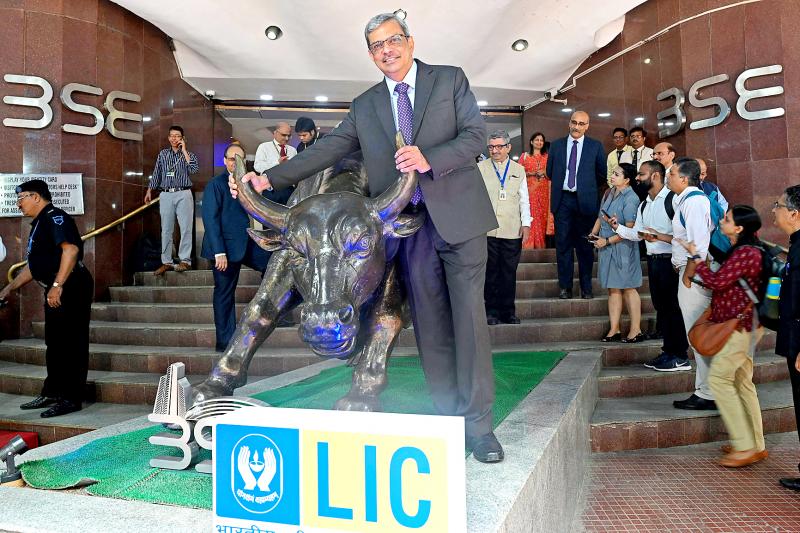State-owned Life Insurance Corp of India (LIC) slumped on its market debut yesterday following the country’s biggest-ever initial public offering (IPO), opening 7 percent below the offer price.
Indian Prime Minister Narendra Modi’s government raised US$2.7 billion by selling 3.5 percent of LIC as his administration seeks to privatize state assets to plug a gaping budget deficit.
However, it was forced to cut back the offer from a planned 5 percent after markets turned volatile following Russia’s invasion of Ukraine and China’s COVID-19 lockdowns.

Photo: AFP
The offer price of 949 rupees had valued LIC at US$77 billion, but it opened yesterday on Mumbai’s exchange trading 7 percent lower. The share price fall expanded to 9.4 percent before recovering slightly.
The muted debut could test the appetite of new shareholders for further flotations of nationalized companies as Modi seeks to sell off state assets to plug an estimated 16.6 trillion rupee (US$213.5 billion) fiscal deficit.
The IPO saw enthusiastic participation from small investors and was oversubscribed nearly three times during the six-day application period.
However, foreign investors have withdrawn a net 1.71 trillion rupees from Indian equities so far this year, stock exchange data showed, as the US monetary policy tightening further roiled sentiment.
Founded in 1956 by nationalizing and combining more than 240 firms, LIC was for decades synonymous with life insurance in post-independence India, until the entry of private companies in 2000.
It continues to lead the pack with a 61 percent share of the market in India, with its army of 1.3 million “LIC agents” giving it huge reach, particularly in remote rural areas.
However, LIC’s market share has slid steadily in the face of competition from net-savvy private insurers offering specialized products.
The firm said in its regulatory filing that “there can be no assurance that our corporation will not lose further market share” to private companies.
The IPO followed a years-long effort by bankers and bureaucrats to appraise the mammoth insurer and prepare it for listing.
LIC is also India’s largest asset manager, with 39.55 trillion rupees under management as of Sept. 30, including significant stakes in Indian blue chips such as Reliance and Infosys.
LIC’s real-estate assets include vast offices at prime urban sites, including a 15-story office in Chennai that was once the country’s tallest building.
The firm is also believed to own a large collection of rare and valuable artwork that includes paintings by MF Husain — known as the Pablo Picasso of India — although the value of these holdings has not been made public.

CHIP RACE: Three years of overbroad export controls drove foreign competitors to pursue their own AI chips, and ‘cost US taxpayers billions of dollars,’ Nvidia said China has figured out the US strategy for allowing it to buy Nvidia Corp’s H200s and is rejecting the artificial intelligence (AI) chip in favor of domestically developed semiconductors, White House AI adviser David Sacks said, citing news reports. US President Donald Trump on Monday said that he would allow shipments of Nvidia’s H200 chips to China, part of an administration effort backed by Sacks to challenge Chinese tech champions such as Huawei Technologies Co (華為) by bringing US competition to their home market. On Friday, Sacks signaled that he was uncertain about whether that approach would work. “They’re rejecting our chips,” Sacks

Taiwan’s long-term economic competitiveness will hinge not only on national champions like Taiwan Semiconductor Manufacturing Co. (TSMC, 台積電) but also on the widespread adoption of artificial intelligence (AI) and other emerging technologies, a US-based scholar has said. At a lecture in Taipei on Tuesday, Jeffrey Ding, assistant professor of political science at the George Washington University and author of "Technology and the Rise of Great Powers," argued that historical experience shows that general-purpose technologies (GPTs) — such as electricity, computers and now AI — shape long-term economic advantages through their diffusion across the broader economy. "What really matters is not who pioneers

BUBBLE? Only a handful of companies are seeing rapid revenue growth and higher valuations, and it is not enough to call the AI trend a transformation, an analyst said Artificial intelligence (AI) is entering a more challenging phase next year as companies move beyond experimentation and begin demanding clear financial returns from a technology that has delivered big gains to only a small group of early adopters, PricewaterhouseCoopers (PwC) Taiwan said yesterday. Most organizations have been able to justify AI investments through cost recovery or modest efficiency gains, but few have achieved meaningful revenue growth or long-term competitive advantage, the consultancy said in its 2026 AI Business Predictions report. This growing performance gap is forcing executives to reconsider how AI is deployed across their organizations, it said. “Many companies

TAIWAN VALUE CHAIN: Foxtron is to fully own Luxgen following the transaction and it plans to launch a new electric model, the Foxtron Bria, in Taiwan next year Yulon Motor Co (裕隆汽車) yesterday said that its board of directors approved the disposal of its electric vehicle (EV) unit, Luxgen Motor Co (納智捷汽車), to Foxtron Vehicle Technologies Co (鴻華先進) for NT$787.6 million (US$24.98 million). Foxtron, a half-half joint venture between Yulon affiliate Hua-Chuang Automobile Information Technical Center Co (華創車電) and Hon Hai Precision Industry Co (鴻海精密), expects to wrap up the deal in the first quarter of next year. Foxtron would fully own Luxgen following the transaction, including five car distributing companies, outlets and all employees. The deal is subject to the approval of the Fair Trade Commission, Foxtron said. “Foxtron will be